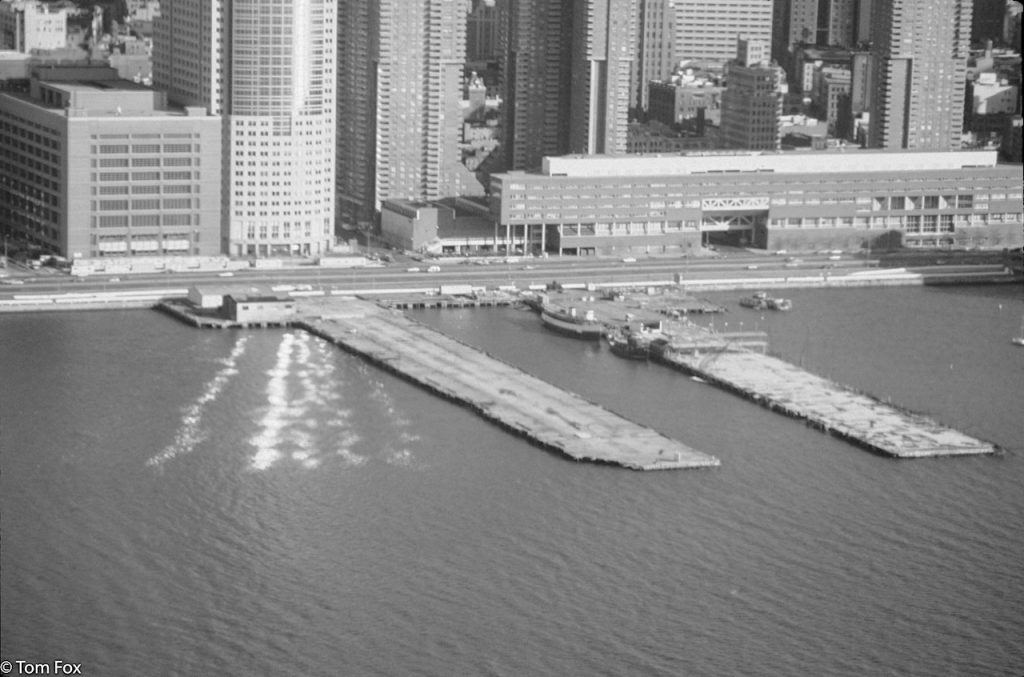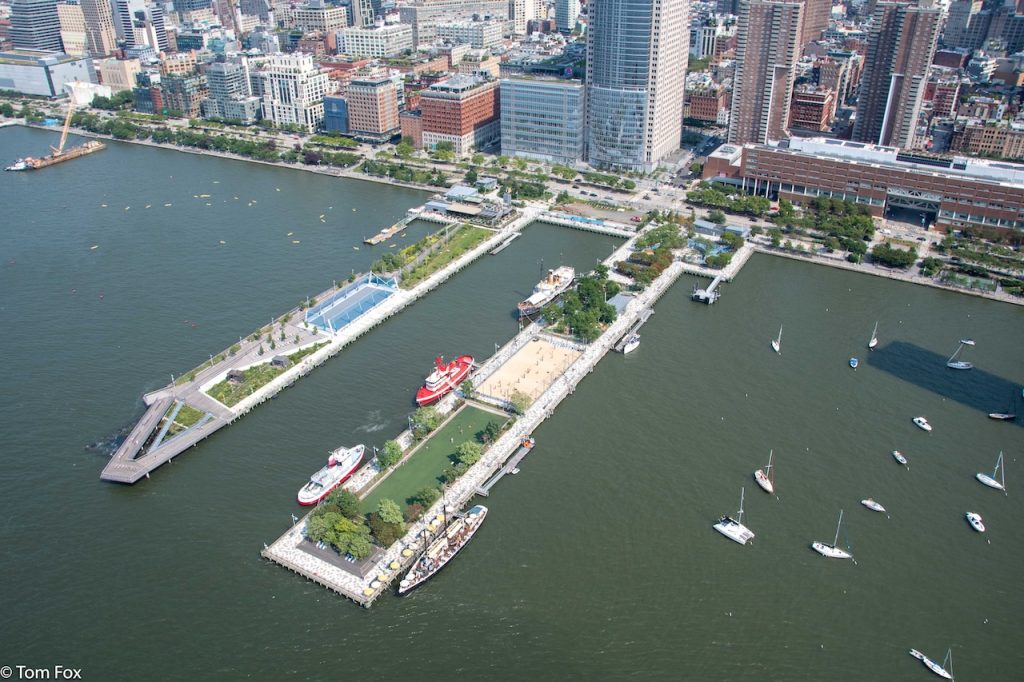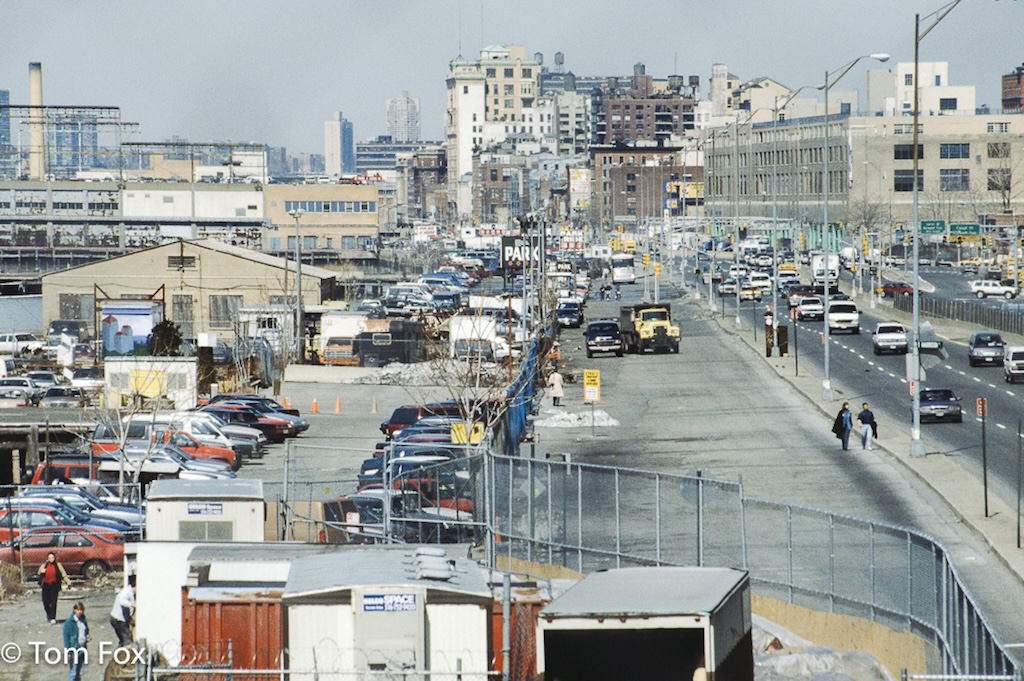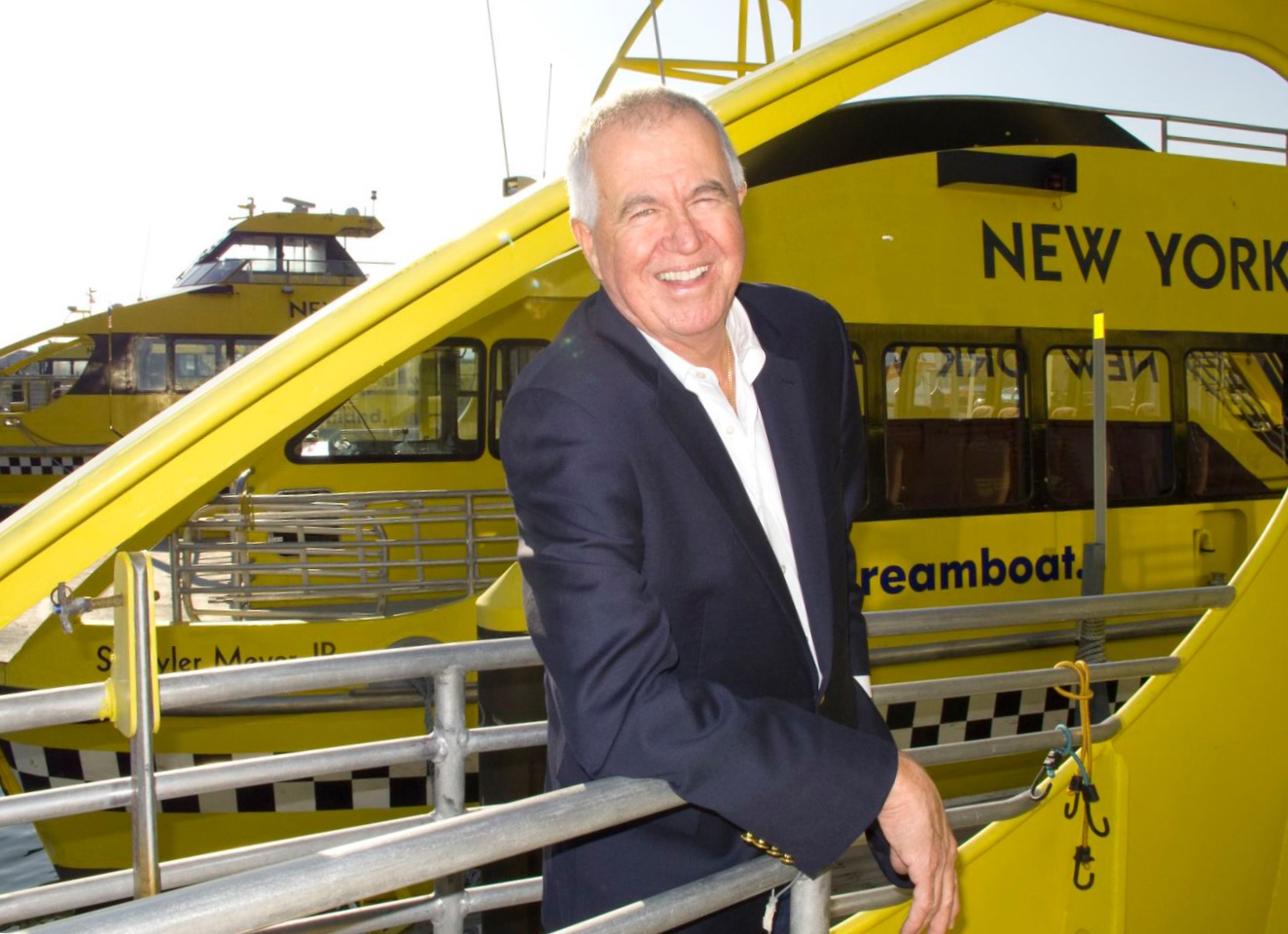BY LINCOLN ANDERSON | Tom Fox, who played a key role in the creation of the Hudson River Park, is holding a book launch party — fittingly, in Hudson River Park.
A five-year labor of love, Fox just published the definitive history of the 4-mile-long West Side waterfront park, “Creating the Hudson River Park: Environmental and Community Activism, Politics, and Greed” (April 2024, Rutgers University Press, 428 pages).
The veteran park advocate will be hosting a free outdoor party tonight, Thurs., May 9, from 5 p.m. to 7:30 p.m., at Pier 25, at N. Moore Street, in Hudson River Park. Fox will read from his book and lead tours of an exhibition of his photos of the West Side waterfront before Hudson River Park aboard the historic steam-powered buoy tender Lilac, which is moored at Pier 25. Photography is a passion of Fox’s and he has documented the park’s progress over the years — even taking to helicopters for aerial shots.
At 550 acres and with nearly two-dozen piers (including all of the Hudson River out to the piers’ tips), Hudson River Park runs from Chambers Street to W. 59th Street. Today, at 26 years old, Hudson River Park attracts more than 17 million visitors per year.
Fox’s book chronicles how the ambitious park came about as a better alternative after the defeat of the hated $2.4 billion Westway project in 1985, which would have landfilled 243 acres in the river, with a sunken highway, and allowed development on top of the landfill.
Fox, who grew up as a hard-working, brainy, ambitious kid in Brooklyn, got involved in parks early on. After serving in Vietnam, he landed a job as a ranger for the National Parks Service at the new Gateway National Recreation Area, which includes Jamaica Bay, Floyd Bennett Field and Jacob Riis Park.
He then moved to the West Village, scoring an apartment with a working fireplace on Bank Street, not far from the river. He joined the Green Guerillas, helping legendary community gardener Liz Christy plant the gargantuan Sequoia redwood that today soars on E. Houston Street at the Bowery.
Fox also became fascinated by the broken-down piers that lined the Hudson River waterfront just steps away from his apartment. He took bike rides on the derelict elevated West Side Highway viaduct. He became active in re-envisioning what the run-down riverfront could become, linking up with other like-minded locals.


His activism and park experience came to fruition in 1992, when Fox was appointed the president of the Hudson River Park Conservancy, the predecessor to today’s Hudson River Park Trust, the state-city authority that is building and operates the park. As such, he was deeply involved in the park’s key early planning.
In his next chapter, Fox went on to co-found New York Water Taxi, becoming an expert on ferries.
As a member of the nonprofit Friends of Hudson River Park, he also served as a watchdog on the park. Fox and the Friends sued to get the W. 30th Street heliport out of the park, though only succeeded in getting tourist flights banned. Because the operator was continuing stealth tourist flights, though, a second lawsuit funded by Fox ally developer Douglas Durst was required. Fox also raised a hue and cry over Pier 57 in Chelsea when the Trust — without reissuing a request for bids — switched the plan for the pier’s commercial tenant from a hawkers night market led by Anthony Bourdain to Google offices, in the process also changing the park’s legislation to allow office use at the pier.
In retrospect, Fox reflected, “It’s better than having a vacant pier.”
Today Fox is still fighting the good fight and holding the park’s administrators accountable as a member of the Hudson River Park Advisory Council.
However, the groundbreaking waterfront park still faces some major decisions, such as the future of Pier 76, at W. 36th Street, and Pier 40, at W. Houston Street. These are both piers where the Trust faces the challenge of balancing recreational and commercial uses. Fox, naturally, is pushing for maximal recreational use. The Trust, for its part, insists the park must be economically self-sufficient — though Fox counters this is a misreading of a clause in the Hudson River Park Act, the park’s 1998 founding legislation. The act says the park should be sustainable “to the extent practicable.”
In fact, Fox would like to see the Trust dissolved and replaced with a traditional park conservancy, such as the one that runs Central Park. He also wants greater transparency, in general, and more community involvement in decision making regarding the park.

He says that, while the park’s leadership is now trending in a positive direction, for too long it has been a “cabal” dominated by development interests tied to the city’s Economic Development Corporation and spinoff planning firms dominated by ex-E.D.C. heavy hitters. The decision, for example, to invest the park’s piers with massive development rights — that could then be transferred to real estate projects inland — was symptomatic of this commercial pressure, he says.
New York City movers and shakers like planning guru Carl Weisbrod, for example, get a skewering in Fox’s recounting of the story of the park.
“No, Carl doesn’t come out well at all [in the book],” he said.
“It’s public land. It’s public money,” Fox stressed. “And we should all have a say in what’s happening — and it should be only for the public good.”
Fox notably was part of a group that sued to stop Barry Diller’s glitzy Little Island project at W. 13th Street. In the face of the environmental lawsuit, Diller scuttled the project — until then-Governor Andrew Cuomo revived it, with a pledge to finish the remaining unbuilt parts of Hudson River Park. Cuomo and former Mayor Bill de Blasio together subsequently ponied up $146 million over two years for the project. Little Island was built and today is an international Instagram magnet full of cultural activities.
Ironically, the book sports a photo of Little Island on its cover. Fox did not have much to say about that, other than that it was a decision reached between him and his editor.
In a sign things are headed in a better direction, Fox said he’s glad to see that Jeffrey LeFrancois, for one, was recently appointed to the Trust’s board of directors. LeFrancois is the chairperson of Community Board 4, the executive director of the Meatpacking District business improvement district and a former head of the Hudson River Park Advisory Council. Most important to Fox, LeFrancois has shown an increasing willingness to challenge the powers that be.
“There shouldn’t be three lanes of traffic in front of Chelsea Piers. Period,” Fox fumed, regarding an issue LeFrancois has been particularly vocal about. “It wasn’t in the original park plan…it’s very complicated. And there shouldn’t be those trailers parked outside for actors from the film studios to change their clothes — that was all supposed to be inside. They’re taking away public space.”
Basically, as a result of the complex’s land grab, there’s no park in front of Chelsea Piers — plus, the bike lane is extra-narrow there.
It’s all in the book, read the book, he stressed.
Similarly, New York Waterway shuttle buses are being allowed to park in front of the Pier 79 ferry terminal, on property that is part of Hudson River Park. This one, according to Fox, is on the city’s Department of Transportation, which is refusing to take action.
“They’re parking buses overnight,” the activist said. “Why should we have to give up public space? They’re not New York vehicles — they have New Jersey license plates. Send ’em back to New Jersey. Outrageous.”
Also, Fox would like to see a “park improvement district” created, under which “inboard” real estate — such as Hudson Yards — whose value has been vastly increased by the park’s creation, would be required to chip in annual funding for the park.


Finally, Fox is currently very focused on coastal resiliency. Like many, he’s outraged that the park could wind up being walled-off by a concrete barrier, if a plan by the U.S. Corps of Engineers goes through. Unlike the East Side Coastal Resiliency project — under which half of East River Park has already been demolished, so that the park can be raised above the floodplain — Hudson River Park won’t be razed and elevated.
“There has to be a [resiliency] task force for the Lower West Side,” he stated. “There can’t be a 12-foot-high wall. That wall was the best thing the Army Corps could have done: That asinine wall has galvanized everybody to say, ‘What the f—?'”
Perhaps Fox’s book on Hudson River Park will go on to become a staple of urban planning studies, like Robert Caro’s “Power Broker” about Robert Moses and Robert Fitch’s “The Assassination of New York” about how big-business interests pushed manufacturing out of town.
Speaking a few weeks ago, Fox said, “I just decided today I’m going to donate a copy to each of the [local] community boards. It should be used as a reference. Nobody knows what happened and the Trust is telling lies that the park has to be self-sufficient — it doesn’t.”
In short, Fox — who learned taekwondo in Vietnam to increase his survival chances — isn’t done fighting for what he feels are the right things to do in his beloved Hudson River Park. Yet, he’s not divulging which issue he’ll take on next.
“You have to keep people off balance,” he explained. “I’m a warrior, always have been, always will be. You don’t telegraph your punches.”


What a terrific history! I agree that big business should stay out of this. Too bad Fox served in that horrible Vietnam War. Maybe he was on orders after enlisting. Incidentally, years ago I worked for the South Bronx Development Organization, Inc., and the head of it, Edward J. Logue, evidently campaigned for the Westway, as I understood it. I was asked to save clippings on the Westway project while I was at the agency. The Westway project was scuttled because it was felt that an endangered species of fish would have a hard time if Westway was built. I agree that there should be NO 12-foot wall; don’t engineers have any sense and feeling?
No concerns that Hudson River Park has basically turned out to be a luxury park/green space amenity for the affluent?
And that more keeps getting added for affluent residents who already have so much….
Perhaps people don’t realize that low-income neighborhoods and the boroughs have much less.
And, incidentally, the City’s budget for next year calls for only $55 million for the Parks Department.
The Park has many restrictions, however, selling art without a permit is exempted from their rules/restrictions on speech (see final paragraph):
https://hudsonriverpark.org/app/uploads/2020/10/2020-Hudson-River-Park-Rules-FINAL.pdf
EXCERPT:
Section 751.05. Regulated uses.
Violation of any provision of this section shall subject the violator to a civil penalty, as specified in the Trust’s penalty schedule in Section 751.07. Unless expressly permitted the following is a list of regulated
activities and uses:
(a) Assemblies, meetings, exhibitions.
(1) It is prohibited for any person to hold or sponsor any special event or demonstration without a permit.
(2) It is prohibited for any person to erect any structure, stand, booth, platform, exhibit or art work in
connection with any assembly, meeting, exhibition or other event or activity without a permit from the trust.
(3) It is prohibited to hold an event that significantly interferes with ordinary park use without a permit. Significant interference includes, but is not limited to, harming landscaping, plantings or
structures in the park, precluding other events that have a valid permit, and unreasonably interfering with the enjoyment of the park by others.
(b) Unlawful vending. It is prohibited for any person to sell, offer for sale, hire, lease or let anything whatsoever within the park, except under and within the terms of a permit for such activity issued by the trust
(q) Unlawful distribution of products and materials.
(1) It is prohibited for any person to engage in the noncommercial distribution of products and/or material (other than printed or similarly expressive material) without a permit. A permit will be
issued only upon the trust’s determination that said distribution will be conducted in a manner consistent with the public’s use and enjoyment of the park or park facility in question